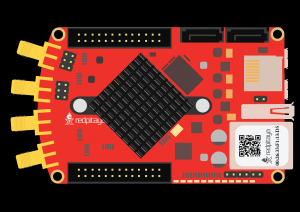2.3.6.1.4. Interactive LED bar graph
2.3.6.1.4.1. Description
This example shows how to make a bar graph by controlling the Red Pitaya on-board LEDs. The number of LEDs that will be turned ON, corresponds to the value of variable p that can be set by the MATLAB® slider bar.
2.3.6.1.4.3. SCPI Code Examples
2.3.6.1.4.3.1. Code - MATLAB®
The code is written in MATLAB. In the code, we use SCPI commands and TCP client communication. Copy the code from below into the MATLAB editor, save the project, and hit the “Run” button. Change p with slider bar from 0-100.
function RP_sliderDemo
f = figure(1);
global p;
%// initialize the slider
h = uicontrol(...
'parent' , f,...
'units' , 'normalized',... %// pixels settings
'style' , 'slider',...
'position', [0.05 0.05 0.9 0.05],...
'min' , 1,... %// Make the "value" between min ...
'max' , 100,... %// max 10, with initial value
'value' , 10,... %// as set.
'callback', @sliderCallback); %// This is called when using the
%// arrows
%// and/or when clicking the slider bar
hLstn = handle.listener(h,'ActionEvent',@sliderCallback);
%// (variable appears unused, but not assigning it to anything means that
%// the listener is stored in the 'ans' variable. If "ans" is overwritten,
%// the listener goes out of scope and is thus destroyed, and thus, it no
%// longer works.
function sliderCallback(~,~)
p = (get(h,'value'));
% Define Red Pitaya as TCP client object
IP = '192.168.178.56'; % Input IP of your Red Pitaya...
port = 5000;
RP = tcpclient(IP, port);
%% Open connection with your Red Pitaya
RP.ByteOrder = 'big-endian';
configureTerminator(RP, 'CR/LF');
if p >=(100/8)
writeline(RP,'DIG:PIN LED0,1');
else
writeline(RP,'DIG:PIN LED0,0');
end
if p >=(100/8)*2
writeline(RP,'DIG:PIN LED1,1');
else
writeline(RP,'DIG:PIN LED1,0');
end
if p >=(100/8)*3
writeline(RP,'DIG:PIN LED2,1');
else
writeline(RP,'DIG:PIN LED2,0');
end
if p >=(100/8)*4
writeline(RP,'DIG:PIN LED3,1');
else
writeline(RP,'DIG:PIN LED3,0');
end
if p >=(100/8)*5
writeline(RP,'DIG:PIN LED4,1');
else
writeline(RP,'DIG:PIN LED4,0');
end
if p >=(100/8)*6
writeline(RP,'DIG:PIN LED5,1');
else
writeline(RP,'DIG:PIN LED5,0');
end
if p >=(100/8)*7
writeline(RP,'DIG:PIN LED6,1');
else
writeline(RP,'DIG:PIN LED6,0');
end
if p >=(100/8)*8
writeline(RP,'DIG:PIN LED7,1');
else
writeline(RP,'DIG:PIN LED7,0');
end
clear RP;
end
end

